Referral Marketing Guide: How to Build a Customer Referral Program?
Harness the power of referral marketing to grow your business
Did you know that referral marketing generates
3 to 5 times higher conversion rates than any other
marketing channel? Referral marketing is a fantastic
opportunity to increase brand awareness and grow
your business. Read on to learn how you can kick
start your own referral marketing program.
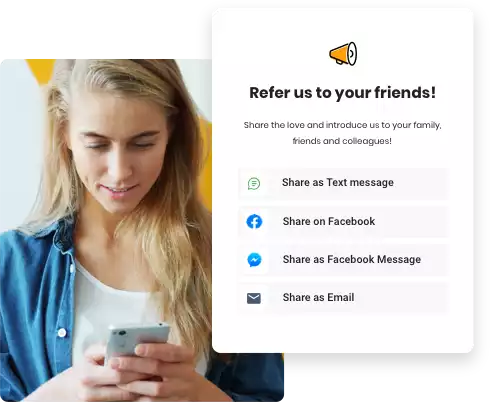
Chapter 1
Referral marketing explained
Use these fundamentals to start
your own referral program for
your business.

Why word of mouth is so powerful
Word of mouth is a powerful concept. We tend to take advice from those who have earned our trust, like our friends, family, or coworkers. Think about it, have you ever asked a friend or family member for restaurant suggestions, what dentist they use, or where to take your car for repairs? If so, then you are familiar with the concept of word of mouth marketing. Word of mouth marketing is effective because it helps businesses:
- gain customer trust
- establish social proof
- remain at the top of customers’ minds
Word of mouth presents a unique opportunity for businesses because it can put you on a fast-track to earning customer trust. When your business is recommended to someone by a person whose opinion they trust, it makes it more likely that they would check out your business. This is how word of mouth builds customer trust right out of the gate.
The concept of social proof is closely related to word of mouth. Social proof is the idea that people generally are influenced by the experiences of other people. For example, if a prospective customer reads great online reviews about your business, they will be more inclined to do business with you. Naturally, they will think, if other people had a great experience with your business, they will too. Customer recommendations are another form of social proof.
Finally, word of mouth helps your business stay at the top of people’s minds. Let’s say you have friends that go to the same dentist, and they have all recommended this practice online. Chances are, if you need to switch to a new dentist, that practice will be the first one you will think of. The more people are talking about your business, the more customers you will attract.
Q: What is referral marketing?
Referral marketing (sometimes called the word of mouth marketing) is when businesses use the concept of word of mouth to get new customers. Happy customers spread the word about the business to their friends and family to help the business grow. Referral marketing programs can take many forms, but all of them use their customers to spread positive word of mouth.

What is a customer referral program?
Customer referral programs are referral marketing in action. Customers are encouraged to refer the business to family and friends, usually through email, SMS text, Facebook, or other online platforms. Here are the different types of referral marketing programs:
- Direct referral program: When you request a referral and offer a reward in return.
- Implied referral program: In an implied referral program, your business finds ways to let your target market know that you are doing work for clients similar to them. For example, let’s say you are an electrician. You could create a pamphlet that showcases your work and leave them at real estate offices and property management offices to serve as a brochure for your business. Implied referral programs are less direct and more difficult to track, yet they can still be effective.
- Tangible referral program: This is when your business offers a product or service for free. For example, many meal subscription services run tangible referral programs by giving referred customers their first meal free of charge.
- Community referral program: This is when your business partners with a non-profit, in hopes that the non-profit organization will in turn support your business.
The referral program that is the most trackable and scalable is the direct referral program. In this article, when we discuss referral programs, we are referring to direct referral programs unless otherwise stated.
There are two types of reward systems, or incentives, for direct referral programs:
- One-sided reward: Just the customer referring your business to someone they know is rewarded.
- Two-sided reward: Both the customer and the person referred receive a reward for participating in the referral program.
As you likely could have guessed, two-sided rewards are much more effective in referral marketing. With a two-sided reward, your happy customers will be more motivated to give referrals, and the referred party will be more likely to follow through with a purchase if they receive a reward or discount.
Q: What is the difference between an ambassador program and a customer referral program?
An ambassador program is simply another way to describe a customer referral program. Both terms refer to the same concept: using customer referrals to spread positive word of mouth about a business to help the business attract more customers.
Chapter 2
How your business can grow with referral marketing
Use these fundamentals to start
your own referral program for
your business.
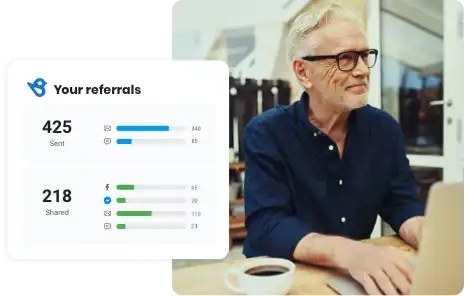
8 Reasons why you need a referral program
Now that you understand what referral marketing is, here are eight reasons why a customer referral program benefits your business.
- Referred customers are more loyal. Referred customers are 18% more loyal than a customer acquired by any other means. Though it may take longer to see the return on your investment with referrals, the leads that you acquire from a referral program are more likely to stick.
- Customers trust referrals more than other forms of advertising. Referrals are your fast track to customer trust. Customers trust the referrals of their friends and family much more than they trust traditional marketing because people’s relationship with traditional marketing is purely transactional. When a family member recommends a business, there is already a relationship of trust, making customers more likely to redeem this referral.
- Referred customers have a higher lifetime value. When you get a new customer through a referral, chances are that customer will have a higher customer lifetime value (CLV) than a customer acquired through another marketing channel. According to the Wharton School of Business, customers who have found a business through referrals have an average of 16% higher CLV.
- Easily increase your brand awareness. Referrals are a conversation piece. The more your customers talk about your brand, the more people learn about you. Referral programs use your happy customers as a funnel to create increased brand awareness.
- Continuous customer engagement Referral programs encourage customers to engage with your brand over time. You don’t want your relationship with your customers to end right after their purchase. You want to keep your customers engaged so that they keep coming back for more. Referral programs intrigue your customers and get them excited about interacting with your business.
- Repeat business Does your referral program offer a discount on the customer’s next purchase? If so, then you have a higher chance of guaranteed repeat business. Referral programs bring you high-quality leads, while also guaranteeing that your customers continue to make purchases.
- Increase in sales Referred customers have a 25% higher profit margin than customers who found your business through another channel. Invest in a referral based marketing strategy and enjoy increased revenue for your business.
- Automatic marketing Once your referral program is up and running, it becomes almost an automatic marketing channel that you can rely on. With automatic referral requests, your customers will still be reminded to send referrals after their purchases, and you can collect new leads without lifting a finger.
Referral marketing is a fantastic opportunity for businesses of all sizes to grow and spread their brand awareness. Read on to learn how you can start a new customer referral program for your business.
Q: Is referral marketing for small businesses?
Referral marketing can be used by small businesses and large corporations alike. As long as you have happy customers and the right tools, referral marketing is possible for businesses of all shapes and sizes.
How to build a strong customer referral program
Here is a comprehensive referral marketing guide to help you establish a solid word of mouth marketing strategy for your business.
Identify your referral incentives
Not every business can (or should) offer the same incentives. What if your company doesn’t have a lot of repeat business? For example, let’s say you run a window business. Most of your customers will not need their windows replaced more than a couple of times in their lifetime. Building a referral program that gives the customer credit would likely not be the best option in this scenario. Instead, gift cards or a cash incentive would work well.
Spread the word
Your referral program cannot be a success if nobody knows about it. Be sure to advertise this program across your website, emails, newsletters, and social media. Here are some ways you can mention your new customer referral program through platforms you are already using:
- Add CTA (call to action) banners to your website. Include a pop-up CTA before a person leaves your website with a mention of the referral program. (Lead with money. If you are offering $50 off, put it in big bold letters. You want to grab the website visitor’s attention to prevent them from going to a competitor.)
- Include your referral program in your customer emails and newsletters
- Always direct customers to your business’s referral page after they’ve made a purchase. This is when they are happiest and most likely to spread the word about your business.
Monitor your program’s effectiveness
Keep track of every participant of your customer referral program. It is just as important to track those who refer your business as those who are taking advantage of that referral. Important things to keep in mind when you are monitoring your new customer referral program:
- Who was the referrer?
- Who was referred?
- Did the referred customer take advantage of the program?
- How long did it take for the customer to take advantage of the referral program?
- How will your business touch base with both – the referrer and the referred?
If you notice over time that referred customers are not taking advantage of the referral program, it might be time to reassess. Are your incentives equally beneficial for both the referrer and the referred? Is your messaging compelling enough? Are you offering the right incentive, or should you rethink the reward you give your customers? Tracking this information will give you an idea of the effectiveness of your customer referral program and help you.
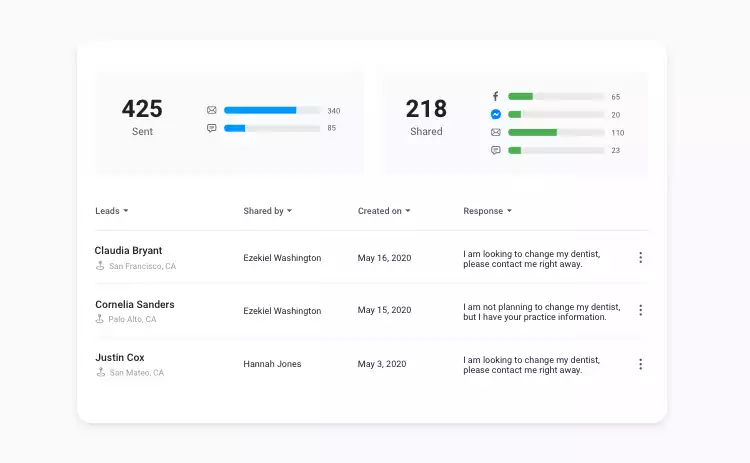
Referral marketing for B2B v B2C
Referral marketing is a great tool for B2B (business to business) and B2C (business to consumer) businesses alike, however, there are some key differences between them. Learn how referral marketing strategies differ between the two so you can create the right strategy for your business.
B2B v B2C Marketing
If you are embarking on a referral marketing program, keep in mind the key differentiators between B2Bs and B2Cs.
- B2Bs have longer decision making processes. There are multiple people to consult and multiple systems to work through before a B2B makes a purchase. It is not enough to convince one person they need your product. Stakeholders, members of the executive team, and other players will need to sign off on a purchase before it can move forward.
- B2Bs want bigger, long-term deals. Though B2Bs take longer to reach their decision, they are in search for bigger, longer term deals. Invest your time in the right B2B leads and you will score big.
- B2Bs seek personalized experience. What does your product do for them? How can it be used for their business specifically? Have you served similar businesses? All of this information is necessary for the B2B to know before they choose your product.
- B2C purchasing decisions are much faster. Marketing should be more focused on grabbing the customer’s attention, rather than building a relationship before a purchase.
- B2C customers have few barriers to purchase. There are fewer steps in the decision making process, oftentimes the decision maker and the buyer are the same.
- B2C relationships tend to be built post-purchase, rather than pre-purchase. While many B2Bs want to have an established relationship with the company before making purchases, B2C customers build relationships through repeat purchases, the support provided, and continuous brand engagement.
How these differences impact referral marketing strategies
For B2B referral marketing, your business will want to follow these steps.
Step 1Identify your current customer satisfaction.
Are your customers generally happy with your product? Do you have great reviews and customer feedback? If not, find out why. Solve any issues you have with customer experience before jump-starting a referral program.
Step 2What customers would be great ambassadors?
Do you have businesses that are already referring your business informally? Do you have businesses that would be eager to refer you? Take a pulse of your customers and see where they are to see how receptive they would be to a referral program.
Step 3Create a starter group for your referral program.
After you have identified several interested customers, have them be the first group you reach out to when starting a referral program.
For B2Bs, avoid sending customers referral requests right after they have made a deal with your business. Though it may be tempting, your customers will want to have an established relationship with you before they can refer your business. Wait until your relationship is established and you know that they are happy with your product and service before you request a referral.
For B2C Marketing, consider the tips below for your customer referral program.
- Send referral requests right after purchase. B2C consumers will not need a long time to consider if they want to refer your business or not. Request referrals after the consumer has made a purchase to capture their attention and reach them when they are happiest.
- Make them feel like one of the team. B2C consumers love to feel involved with brands that they are passionate about. Use your referral program to get them engaged. Consider setting up a referral rewards program where customers receive swag after sending a certain amount of successful referrals. This will improve their customer experience, and encourage them to keep participating in the referral program.
- Make your referrals shareable. Customers want to be able to share their referrals through social media, text, or messaging apps. The easier you make this sharing, the more likely you are to see engagement with your consumers.
- Utilize social media. Feature your top ambassadors on your social media channels. Your customers will love this recognition and it will encourage them to keep spreading the word.
Referral programs are valuable for both B2Bs and B2Cs, however the approach you take may need to be monitored slightly to fit your customer’s needs best.
Referral program examples
Here are some examples of how different businesses have executed some very successful referral marketing programs:
Airbnb
Airbnb pays customers for referrals in the form of Airbnb credits. In this two-sided reward, both the referrer and the person who has been referred win, and there is no limit to how many people a customer can refer.
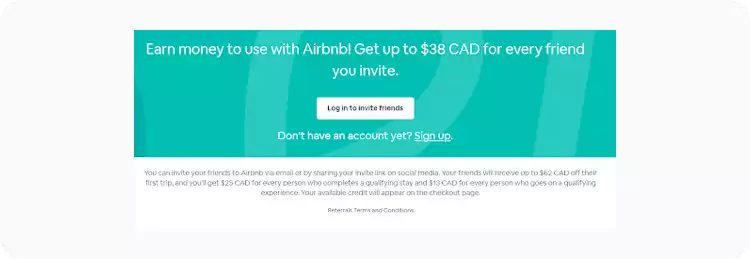
Dropbox
Dropbox is a referral marketing success story. They experienced 3900% growth by offering a two-sided reward program, where both the referrer and the newly-referred customer were rewarded with 16GB of free space. By offering a compelling incentive and making the referral process a breeze, Dropbox was able to grow their customer base at an astonishing rate.

HelloFresh
HelloFresh is getting referrals from customers through their “Refer a Friend” program. Each user gets a unique referral code from HelloFresh, and when their friend redeems that code, both parties receive a discount. Even better? HelloFresh clearly states that there is no limit to how many referrals their customers can make.
HelloFresh also offers a tangible reward program where customers can send friends a free week of meals.
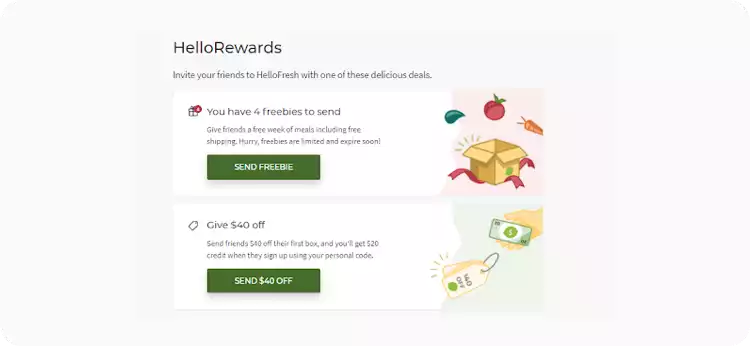
Quip
The toothbrush company Quip has customer referral program benefits where both parties receive $5 off of their order for participating in the referral program.
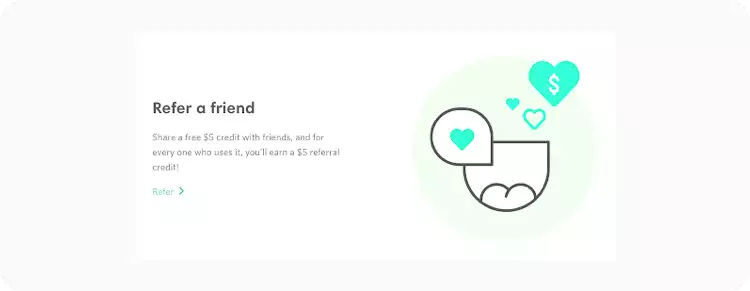
These companies demonstrate a range of benefits. It’s important to note that some of them are as small as $5. This just goes to show, if you are engaging with your happy customers, they will be eager to spread the word about your brand, regardless of the size of their reward.
Referral marketing solutions
Referral marketing is intuitive and can be quite rewarding if done the right way. While it might be tempting to do everything manually, remember, referral marketing involves many steps – send referral requests, track who referred your business, which new customer came from which referral request, send a thank you note or a promised gift card etc.
Efficient deployment, tracking, and monitoring progress are key to the success of any referral program. A good referral marketing software can help you successfully implement and monitor your referral marketing plan. When you are searching for a referral marketing software, look for the following key features:
- Automation. Invest in a software solution that can automate referral requests. This way, you can get new leads without needing to manually request each customer to give your business a referral.
- Integration. The right software should let your customers refer your business through multiple platforms like email, SMS text, and social media.
- Customizable templates. Does the software have customizable referral request templates? It’s important that your requests look and sound like your brand or else customers may think that they are in the wrong place. Make sure that the solution you pick lets you customize your referral requests to deliver an omnichannel customer experience.
- Notifications. The tool you use should send you notifications whenever you get a new referral so that you can engage with the prospect right away.
- Reporting. Can you see all of your referrals in one place? Find a software solution that helps you follow your referral engagement along every step of the process.
The right referral program software will have the above attributes (and more!) to make referral marketing implementable for businesses of all shapes and sizes.

Best practices for your referral program
As you go forward with designing your business’s own referral program, here are some helpful tips and best practices for referral marketing to remember.
- Know your customers. Your referral program cannot be a success if you do not understand who your customers are or what they want. Ask yourself, what do your customers value? What brings them to your business? What keeps them coming back? Once you’ve answered these questions, you can start thinking about what incentives would pique your customer’s interest.
- Visualize success. What does a successful referral program look like to you? What are you hoping to achieve from this program? Are you trying to grow your customer base? Increase your revenue? The more specific you can be with your goals, the better you will be able to identify the effectiveness of your referral program. It’s important that your business is seeing a return on the time, effort, and money you are investing into your referral program. Setting the right benchmarks goes hand in hand with visualizing your success. To accomplish this, design your own referral marketing funnel and monitor its progress.

- Be patient. You may not see the benefits from your referral marketing strategy right away. This does not mean that it is not effective. Referral marketing has been proven to have high return on investment, but it does take time. Be patient. Some of your best leads may have received a referral and are simply waiting for the right time to redeem it.
- Make your program your own. Though referral marketing works for many different industries, do not get caught up in comparing your referral program to another business’s. This can distract you from your objective and you could be chasing the wrong goals. Make your referral program your own. Identify what success looks like for your business, and what you can do to get there.
- Always thank your customer. Remember, even if there is an incentive in place, customers are still doing you a favor when they send referrals. Because of this, it’s important to show your appreciation. Send every customer who refers your business a heartfelt “Thank You” email. Make sure this email has no other advertisements. If you include mentions of your new products or offers, it may seem like you are trying to get them to spend more money right away. In this scenario, you will seem opportunistic, not grateful. Sending a “Thank You” email will help your customers feel appreciated and improve their overall customer experience.
How Elite CXS can help
Amplify the voices of your happy customers and attract new ones through Elite CXS Referrals. Though referral marketing may be an investment of your time, a referred customer is 18% more loyal than a customer acquired by other means. Gain more customers that value your brand long-term through Referrals.



